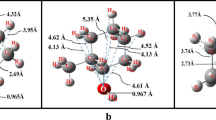Abstract
It is well known that the properties of mixtures may be very different from those of the pure constituent components, due to the unlike forces. Even for mixtures composed of simple molecules, this behavior can be rather complicated at high pressures, where the system may exhibit gas–gas equilibrium, a critical double point and density inversions. A few mixtures such as He–H2 and He–N2 are discussed. It is demonstrated that Raman spectroscopy is an important tool not only for obtaining knowledge about the dynamical behavior of mixtures but also for determining phase equilibria at high pressures. The frequency shift, the linewidth, and the line shape provide information about the solubility, the state of aggregation, and other conditions of the system. Recently, a new type of compound has been found, the so-called van der Waals compound. The results obtained in simple mixtures, such as Ne–N2 and Xe–N2, are compared with the results of molecular dynamics (MD) simulations of hard sphere mixtures. It is pointed out that energy, and not a geometrical effect (or entropy), is the driving force for compound formation.
Similar content being viewed by others
REFERENCES
W. B. Streett and A. L. Erikson, Phys. Earth Plan. Int. 5:357 (1972).
L. C. van den Berg, J. A. Schouten, and N. J. Trappeniers, Physica A 132:549 (1985).
J. A. Schouten, L. C. van den Berg, and N. J. Trappeniers, Chem. Phys. Lett. 114:401 (1985).
L. C. van den Berg and J. A. Schouten, J. Chem. Phys. 89:2336 (1988).
M. G. E. van Hinsberg, R. Verbrugge, and J. A. Schouten, Fluid Phase Equil. 88:115 (1993).
M. Ross, J. Chem. Phys. 71:1567 (1979).
W. Zhang, Thesis (University of Amsterdam, Amsterdam, 1996).
K. Shukla, Fluid Phase Equil. 99:153 (1994).
J. A. Schouten, M. G. E. van Hinsberg, M. I. M. Scheerboom, and J. P. J. Michels, J. Phys. Condens. Matter 6:A187 (1994).
J. A. Schouten and L. C. van den Berg, Fluid Phase Equil. 32:1 (1986).
W. L. Vos, L. C. van den Berg, and J. A. Schouten, Int. J. Thermophys. 10:15 (1989).
K. S. Schweizer and D. Chandler, J. Chem. Phys. 76:2296 (1982).
G. S. Devendorf and D. Ben-Amotz, J. Phys. Chem. 97:2307 (1993).
J. P. J. Michels, M. I. M. Scheerboom, and J. A. Schouten, J. Chem. Phys. 105:9748 (1996).
J. P. J. Michels and J. A. Schouten, Int. J. Thermophys. (in press).
M. E. Kooi and J. A. Schouten, Phys. Rev. B57:10407 (1998).
M. E. Kooi and J. A. Schouten, Phys. Rev. B60:12635 (1999).
A. Deerenberg, J. A. Schouten, and N. J. Trappeniers, Physica A 103:183 (1980).
R. B. Griffiths and J. C. Wheeler, Phys. Rev. A 2:1047 (1970).
M. I. M. Scheerboom and J. A. Schouten, Phys. Rev. E 51:R2747 (1995).
W. Hume-Rotary, G. W. Mabbott, and K. M. Channel-Evans, Phil. Trans. Roy. Soc. A 233:1 (1934).
W. G. T. Kranendonk and D. Frenkel, Mol. Phys. 72:679 (1991).
M. D. Eldridge, P. A. Madden, and D. Frenkel, Nature 365:35 (1993).
X. Cottin and P. A. Monson, J. Chem. Phys. 102:3354 (1995).
W. L. Vos, L. W. Finger, R. J. Hemley, J. Z. Hu, H. K. Mao, and J. A. Schouten, Nature 358:46 (1992).
M. S. Somyazulu, L. W. Finger, R. J. Hemley, and H. K. Mao, Science 271:1400 (1996).
J. A. Schouten and M. E. Kooi, in High Pressure Molecular Science, NATO Sci. Ser. E, Vol. 358, R. Winter and J. Jonas, eds. (Kluwer, Dordrecht, 1999), p. 187.
P. Loubeyer, in The Properties of Simple Molecular Binary Mixtures at High Density: A Qualitative Understanding, R. Pucci and G. Picitto, eds. (Elsevier, Amsterdam, 1991), p. 245.
W. L. Vos and J. A. Schouten, Sov. J. Low Temp. Phys. 19:481 (1993).
W. L. Vos and J. A. Schouten, Phys. Rev. Lett. 64:898 (1990).
H. Olijnyk and A. P. Jephcoat, J. Phys. Condens. Matter 9:11219 (1997).
L. D. Yantsevich, A. I. Prokhvatilov, and A. P. Brodyanskii, J. Low. Temp. Phys. 111:429 (1998).
Author information
Authors and Affiliations
Rights and permissions
About this article
Cite this article
Schouten, J.A. What is Different in Mixtures? From Critical Point to High Pressures. International Journal of Thermophysics 22, 23–40 (2001). https://doi.org/10.1023/A:1006732330320
Issue Date:
DOI: https://doi.org/10.1023/A:1006732330320




